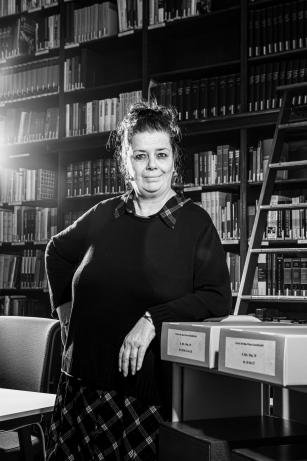One of 24,000
- Mar 30, 2023
- In the Media
- Dept. Renn
- Birgit Kolboske
Interview with Research Scholar Birgit Kolboske, republished from MaxMag 1/2023.

Birgit Kolboske. Source: Gesine Born, 2023.
Ms Kolboske, you were a member of the programme that researched the history of the Max Planck Society (GMPG). How did you get involved in the programme?
I had already worked on the preceding project that investigated the Kaiser Wilhelm Society and its involvement with the Nazi regime. Back in 2001, I worked as the project and editorial assistant and was responsible for publications. Then, after working freelance as an interpreter and editor for some time, I returned to the MPG and began coordinating the preliminary phase of the GMPG project. With the support of Jürgen Renn, programme coordinator and Director at the MPI for the History of Science, I was able to introduce and research the topic of gender as a research focus.
What exactly did you investigate?
The initial question was: how to tell the history of women in the Max Planck Society, in the most representative and inclusive sense? Eventually, I settled on two areas: the one, where only very few women were admitted — science; and the other, where most of them worked most of the time — the office.
What was the thought process behind dividing up the different roles of women that you looked at?
Considering the inclusion or exclusion of female scientists on the basis of the Harnack Principle was an obvious choice. The archives provided me with a wealth of material on this – be it minutes of meetings of the Sections, the Executive Committee or other documents. One reason for choosing the other area accrued from my good contacts to secretaries due to my former work. I knew what they accomplish and how hierarchical the structures were, especially in the office. It was quite a challenge as the sources here are quite sparse. Here the interviews and conversations I had with colleagues and contemporary witnesses proved very helpful. And the fact that many materials had already been digitised.
You also looked at the MPG’s approach to gender equality in comparison to changes in society. What was your conclusion?
Just like the scientific community in general, the Max Planck Society clearly lagged behind social trends in this area. However, when it comes to gender equality or inclusion, compared to other European countries, Germany was, and continues to be, anything but a pioneer. It is thanks to the General Works Council, in particular its Women’s Committee, that something changed in this area at the MPG. Minutes from the archives show, for example, that there were organised protests by employees in the form of open letters and petitions against a gender policy that was perceived as too half-hearted, such as in the case of the draft of a general works agreement on gender policy rejected by President Hans Zacher in January 1994.
What are your wishes for the MPG on its birthday?
First of all, continued success in science, of course. But also the courage to implement cultural change. That means living the Harnack Principle inclusively or rather implementing it consistently. That is, finding and recruiting the best minds, regardless of gender, colour, age or possible physical limitations.
